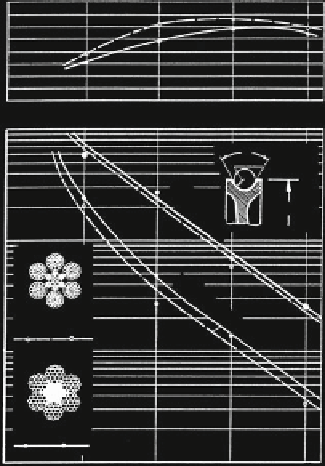Civil Engineering Reference
In-Depth Information
Fig. 3.44 Number of
bending cycles of two wire
ropes, lubricated and
degreased, Müller (
1966
)
8
6
4
2
0
10
6
°
R=0.53d
60
D= 25d
10
5
6x(1+7+(7+7)+14)
+ 7x (1+6)
10
4
6x(1+6+(6+6))+1H
10
3
0
10
20
3
k
4
rope tensile force S
tests. The eff
ec
t of the re-lubr
ica
tion was to increase the mean number of bending
cycles from N ¼ 246
;
000 to N ¼ 392
;
000 The standard deviation for logarithm
distribution is lg s = 0.038 and lg s = 0.047, based on the bending length 45d.
A larger number of bending fatigue tests, both with and without re-lubrication,
were carried out with seven parallel strand ropes with the rope diameters between
12 and 16 mm, Feyrer (
1998
). Figure
3.46
shows the ratio of the breaking numbers
of bending cycles N
m
/N with (index m) and without re-lubrication (no index). By
regression calculation, the breaking number of bending cycles with re-lubrication
is
N
m
¼ 0
:
0316
N
1
:
307
:
ð
3
:
56
Þ
and the discarding number of bending cycles with re-lubrication is
N
Am
¼ 0
:
0682
N
1
:
248
:
ð
3
:
57
Þ
A
Normally, the number of bending cycles will be increased by the re-lubrication.
However, if the wire rope without re-lubrication only reaches the numbers of
bending cycles N = 80,000, respectively, N
A
= 50,000, there is no increase in
endurance to be expected. Moreover, up to these limits the numbers of bending
cycles may be even reduced by re-lubrication, Fig.
3.46
.

Search WWH ::

Custom Search